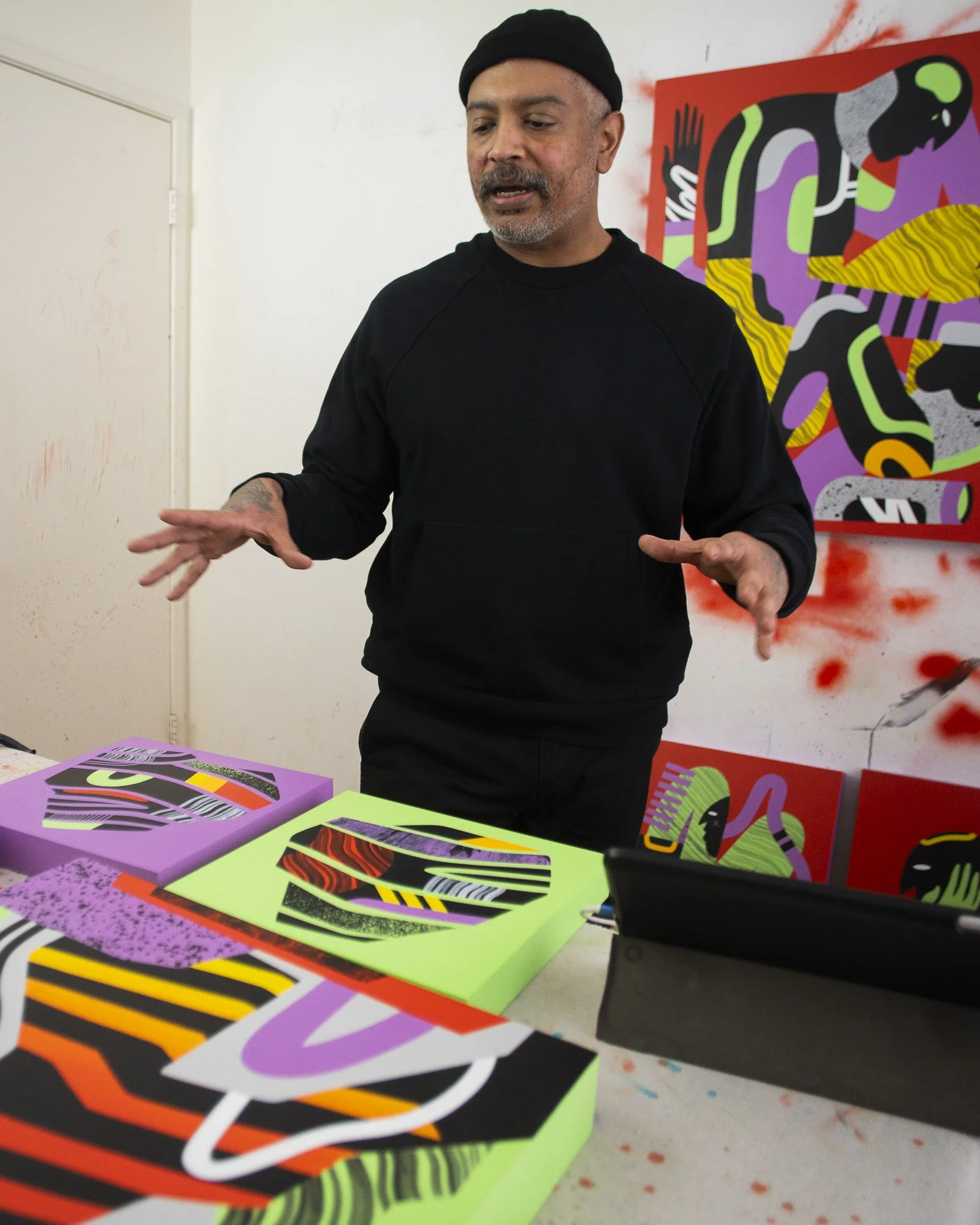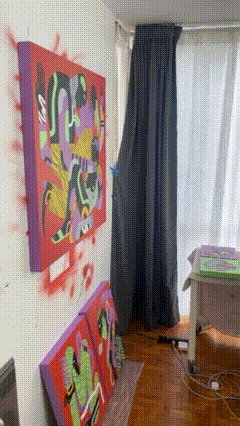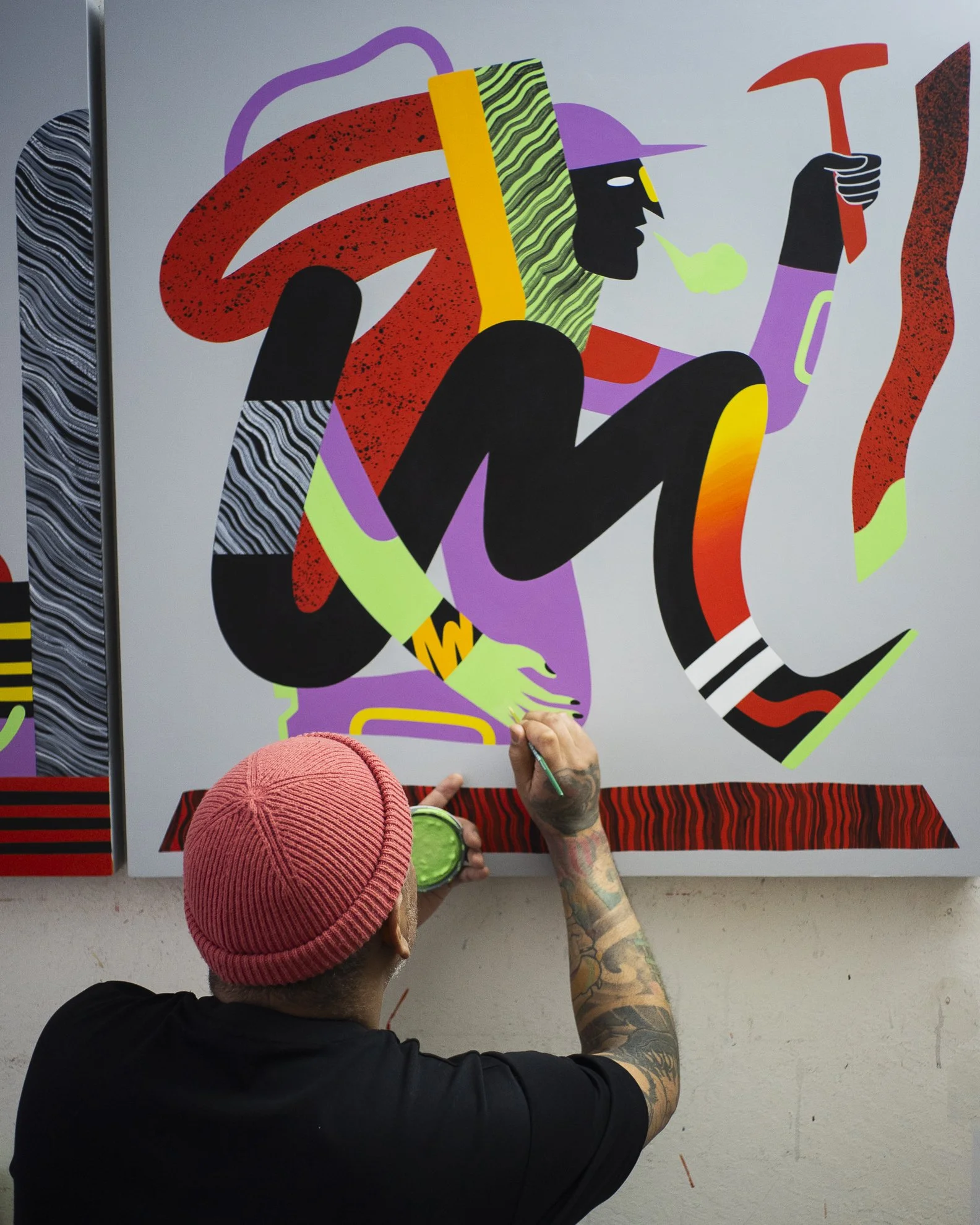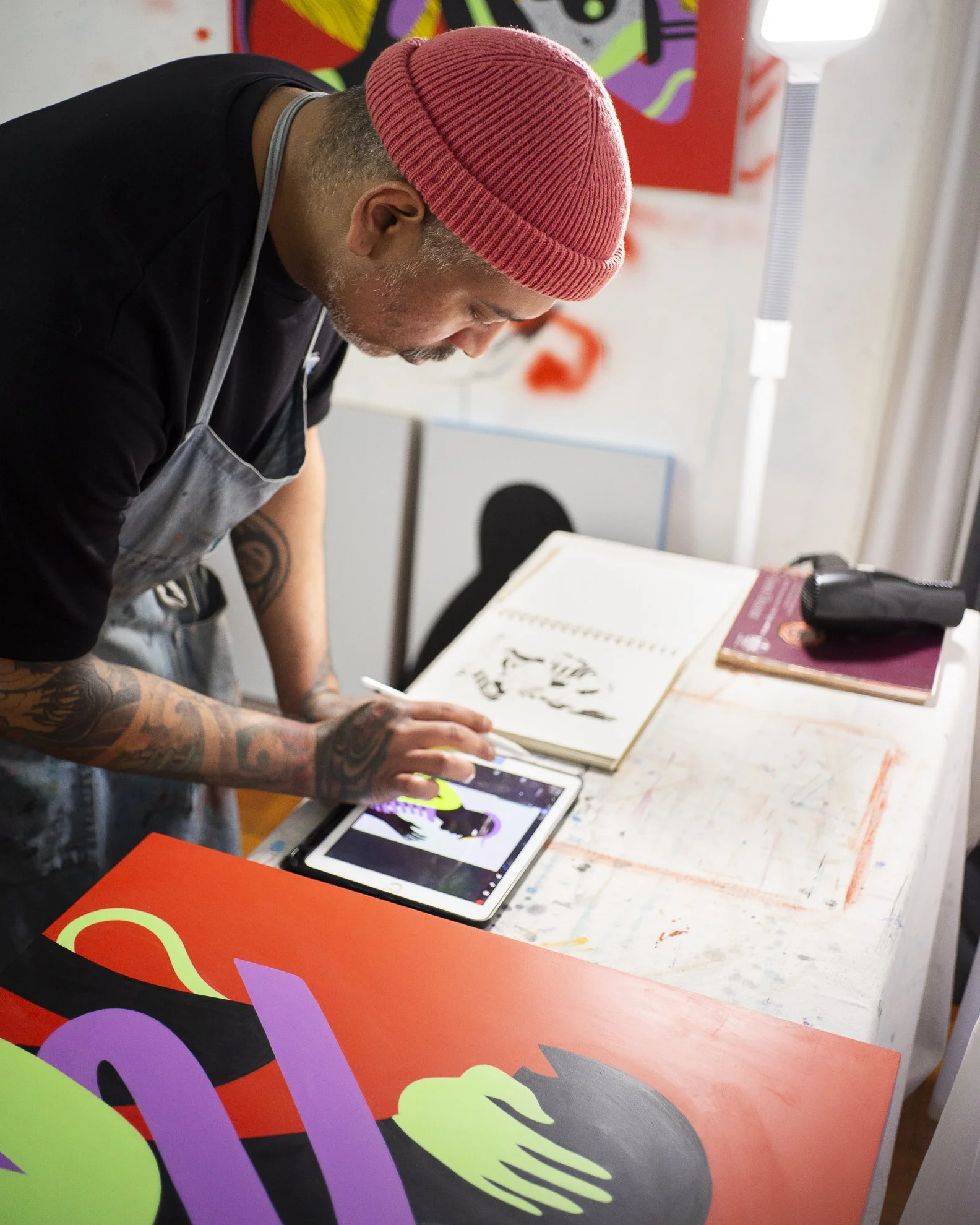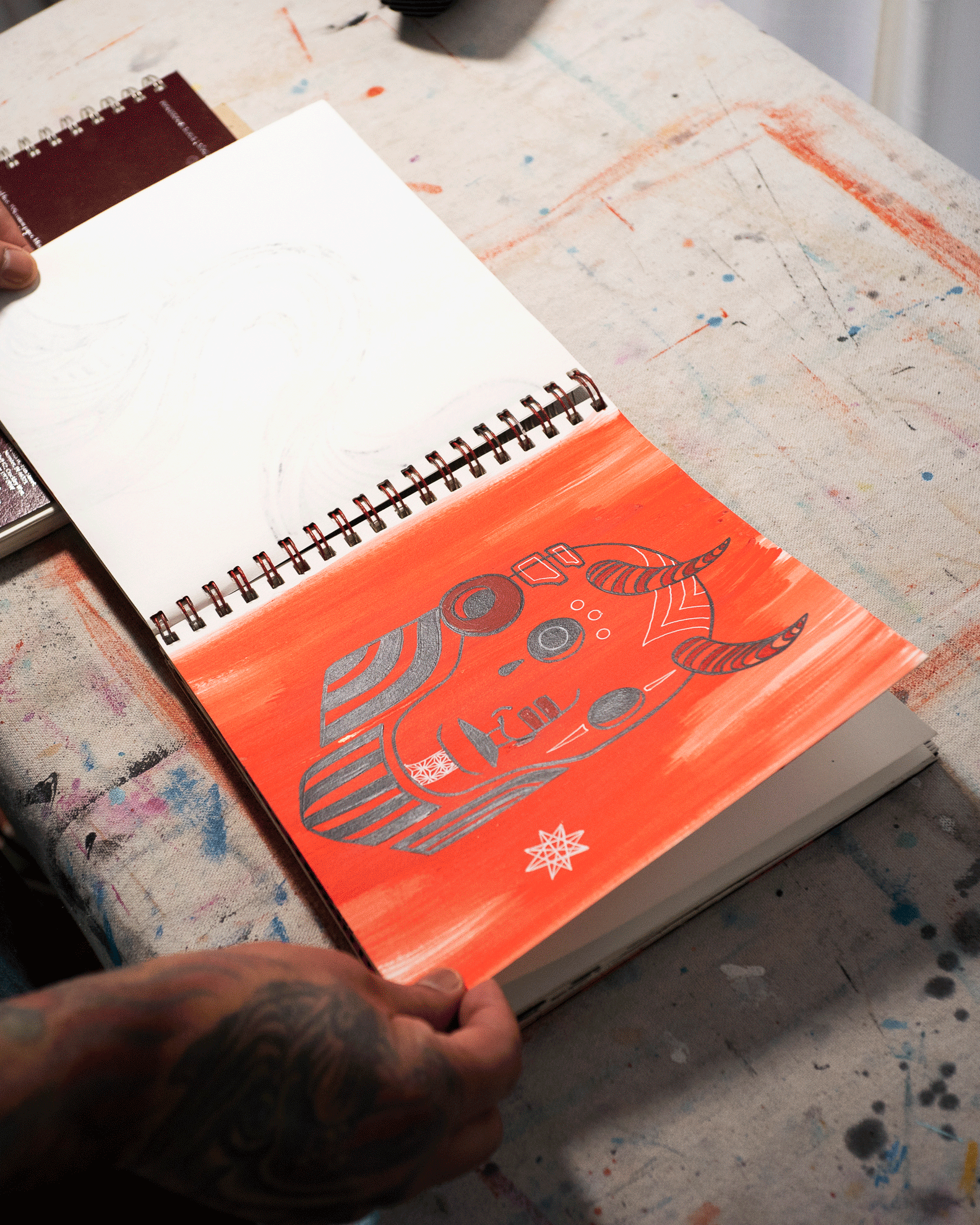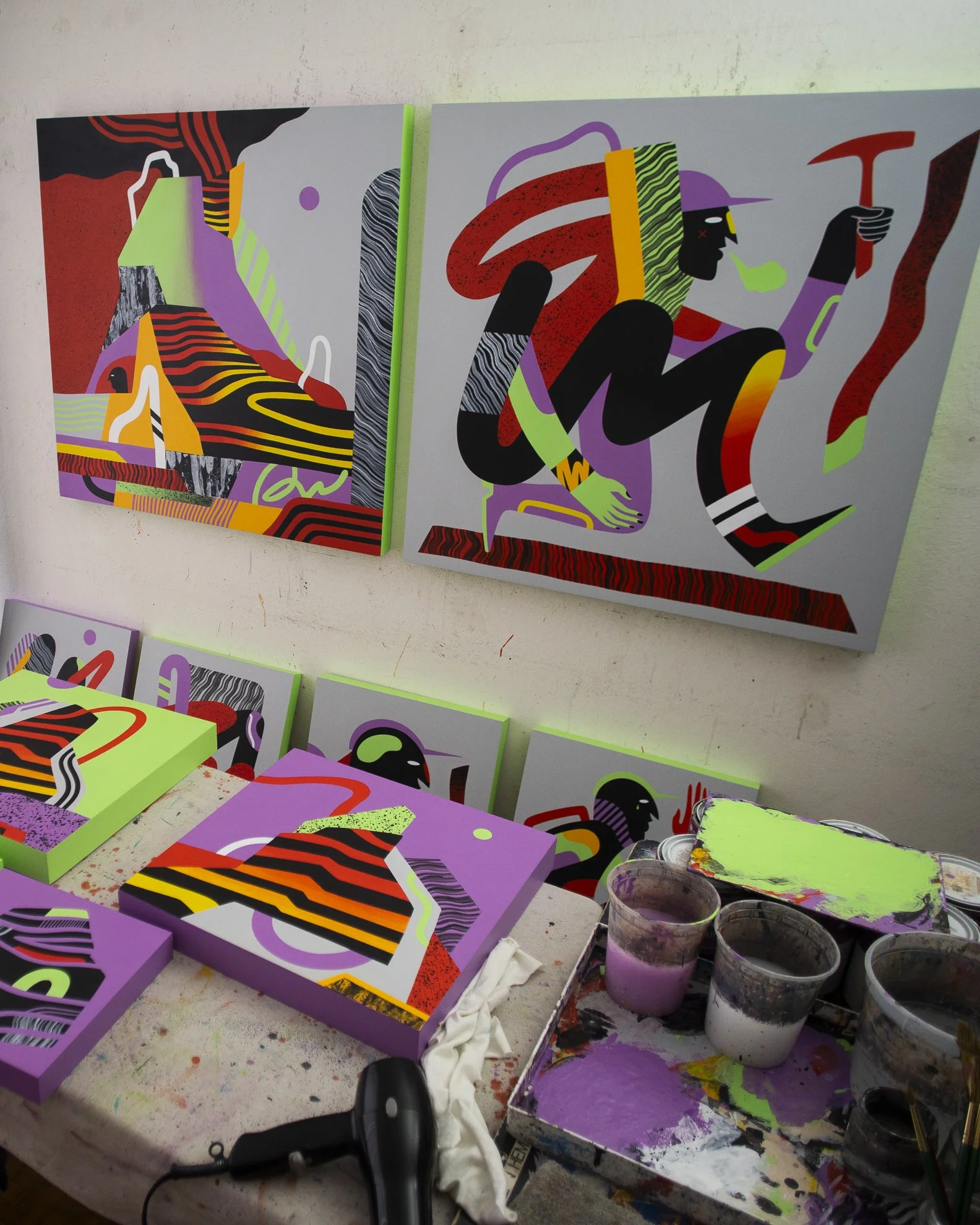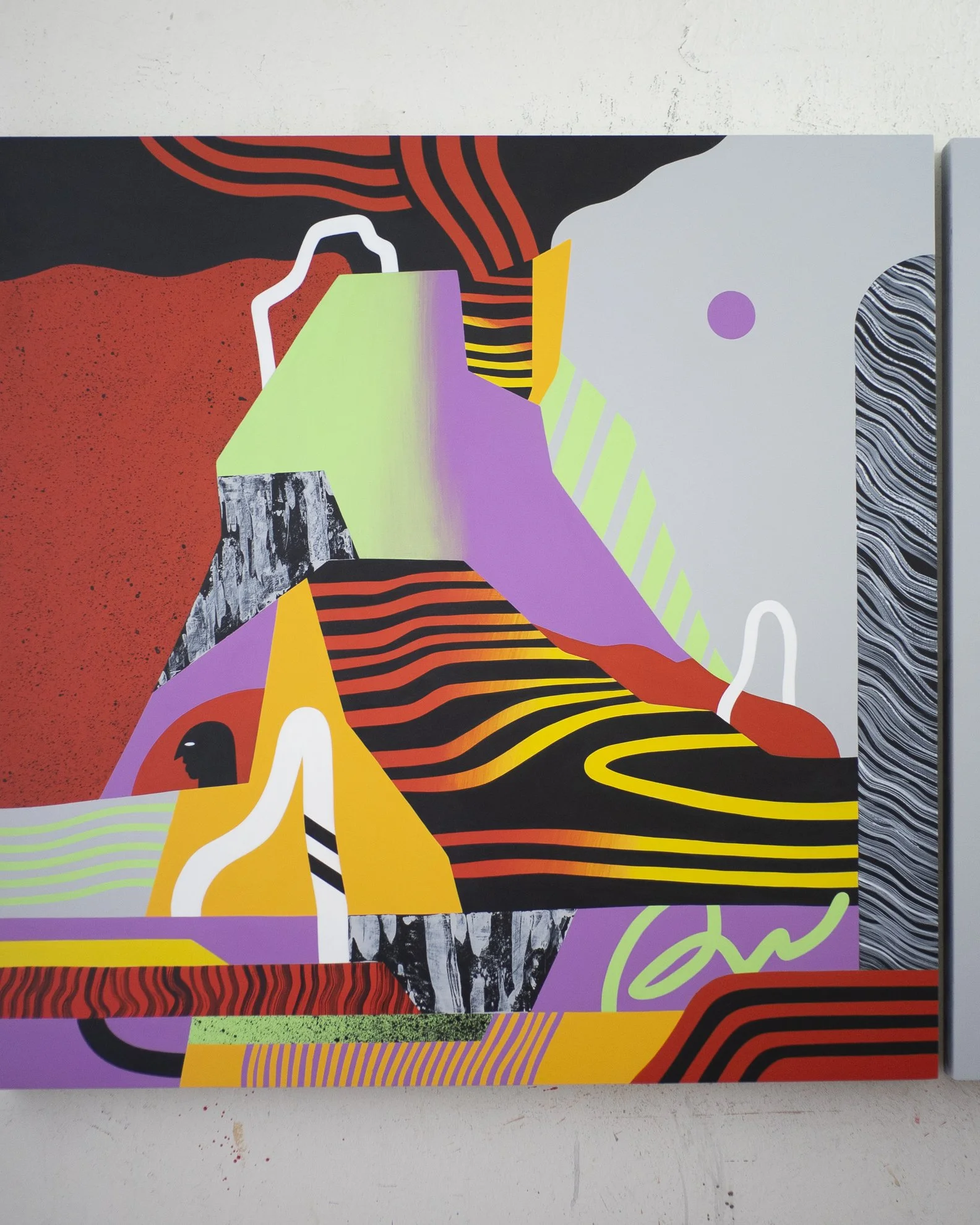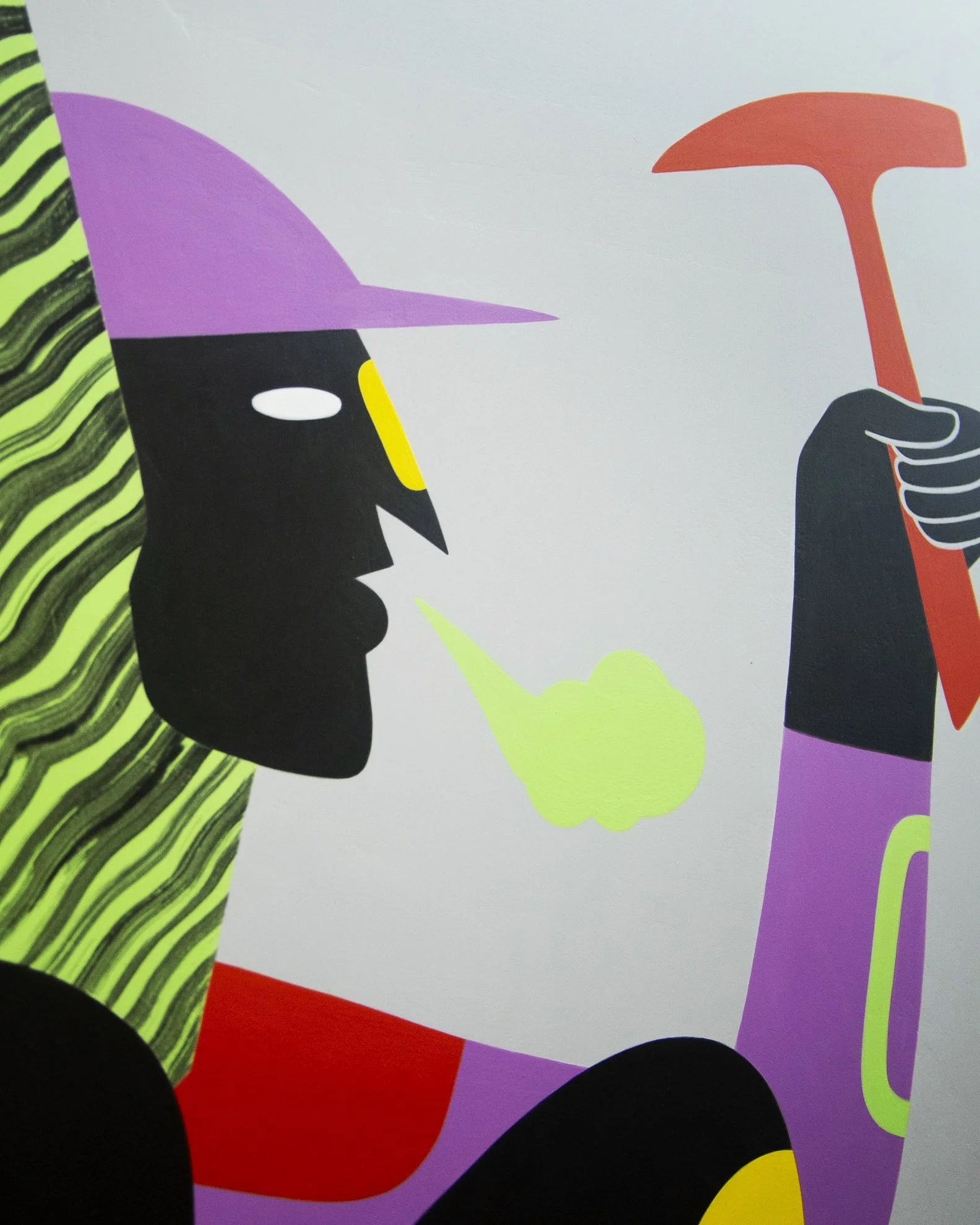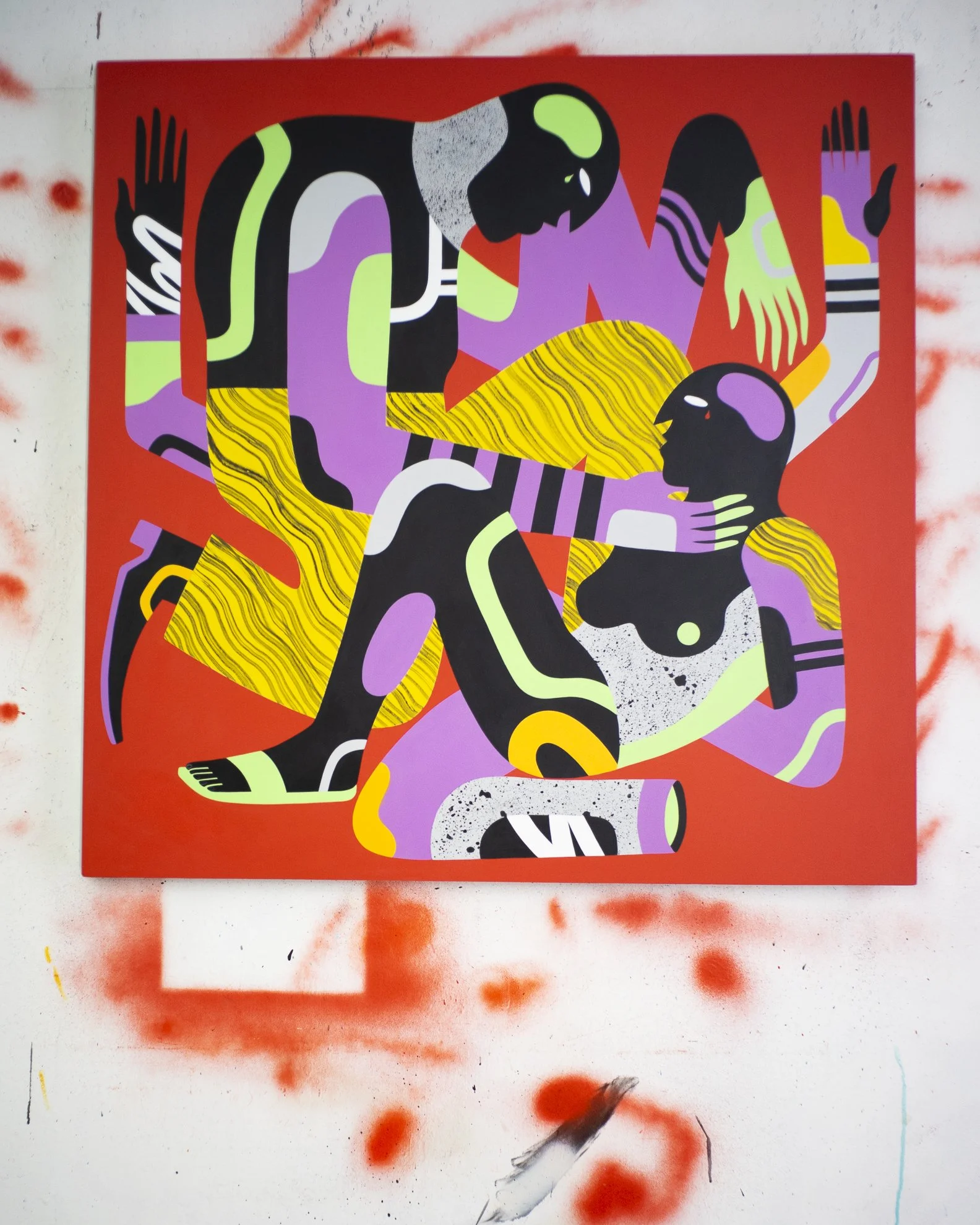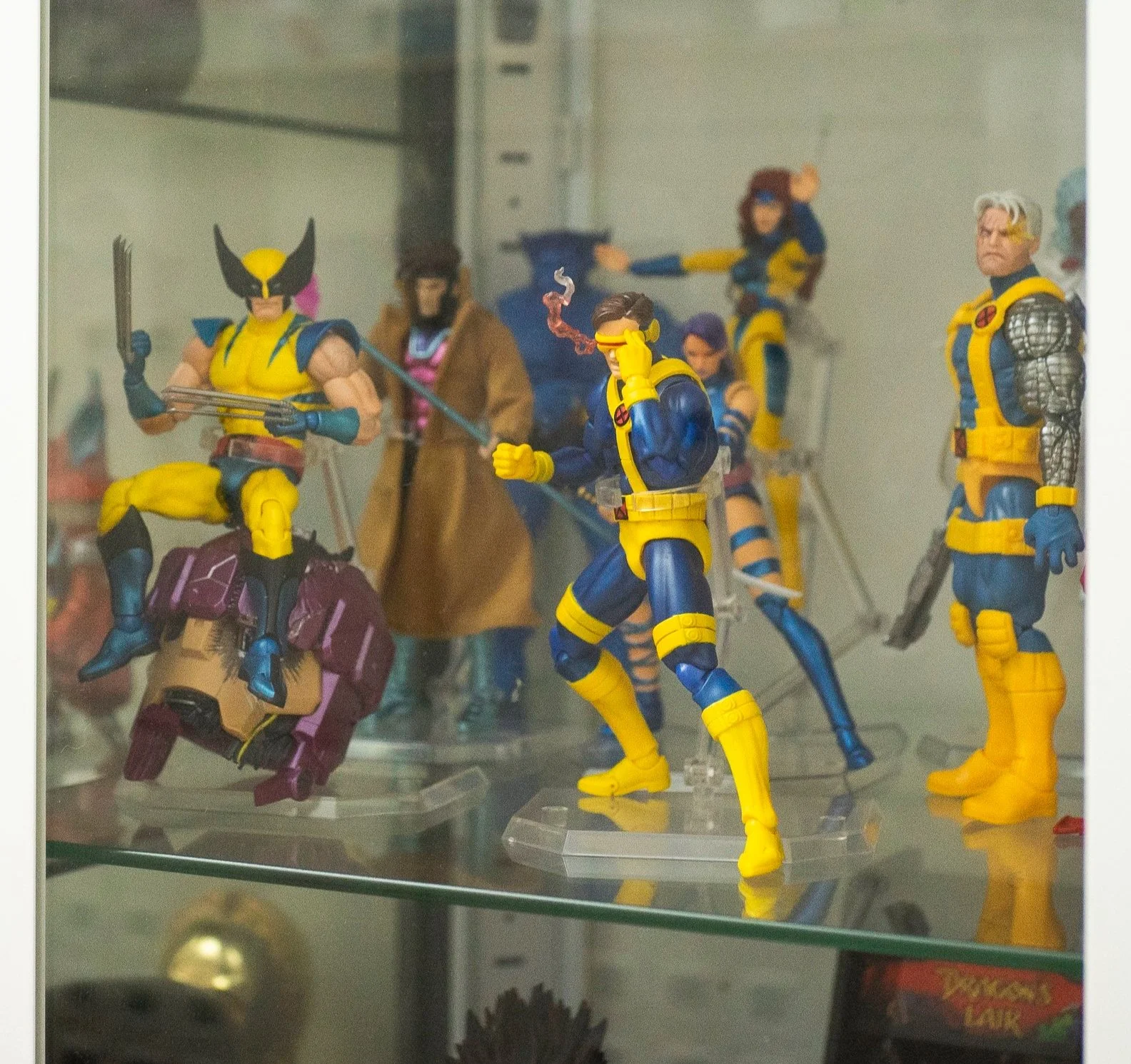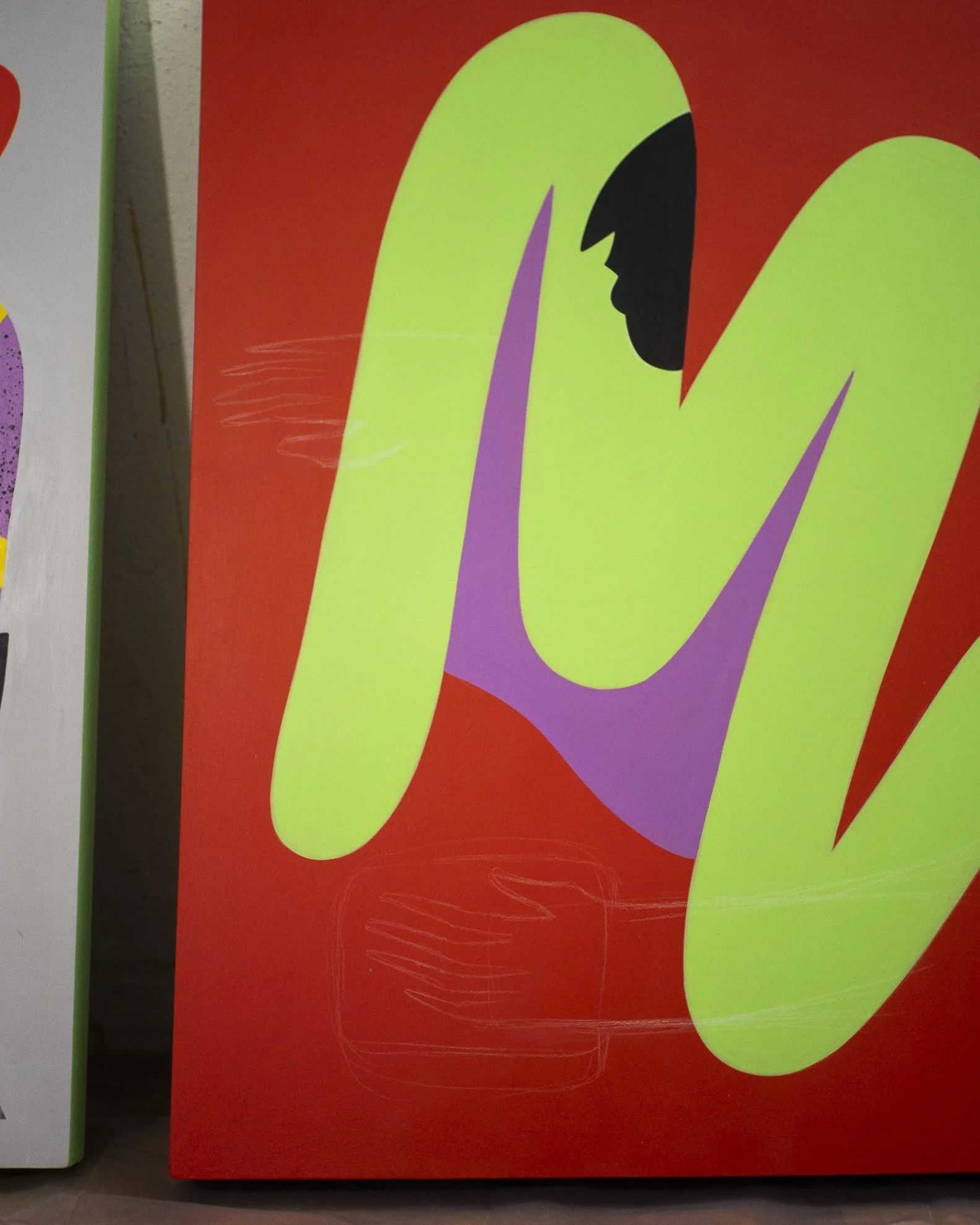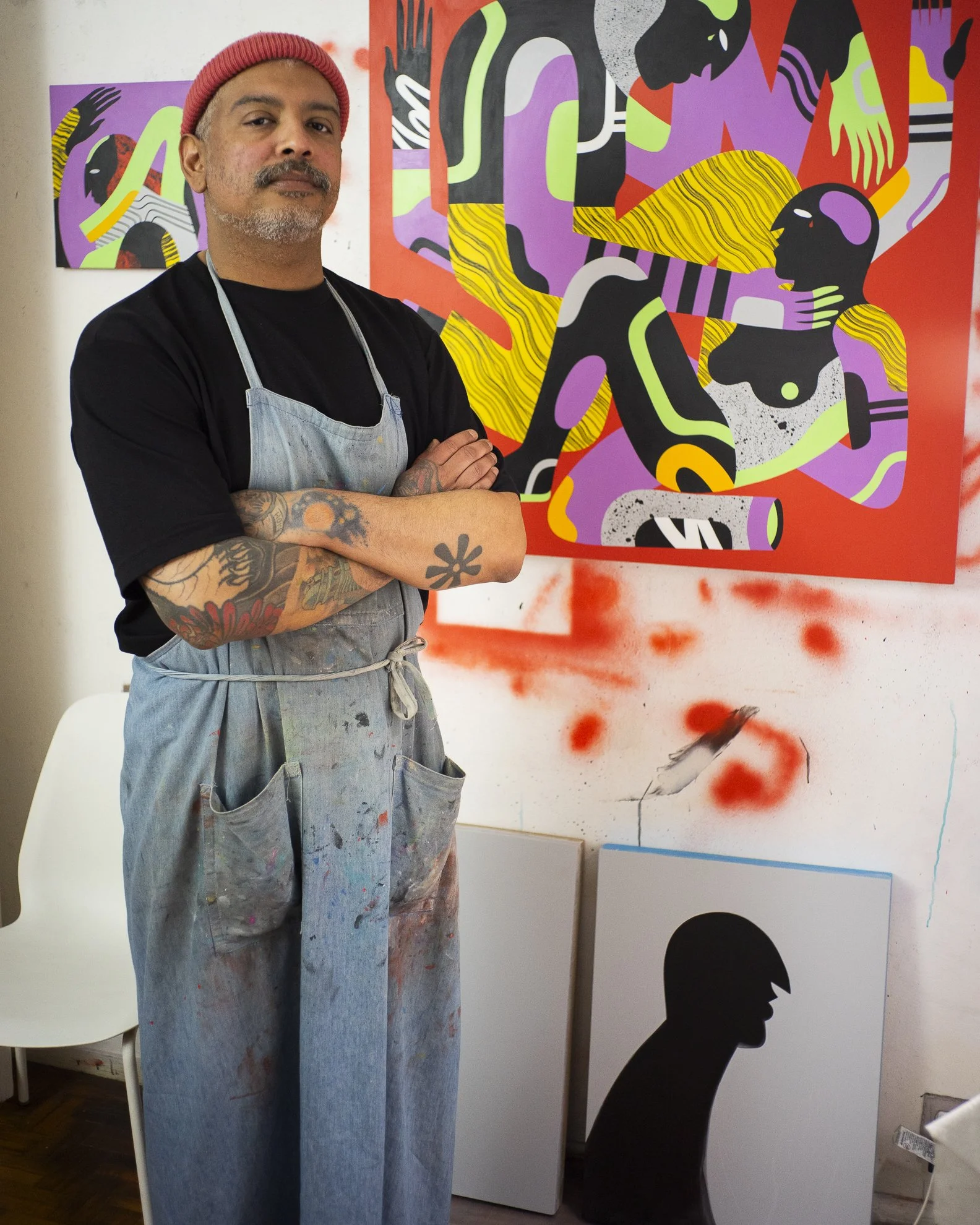Studio Visit & Interview With Santos Shelton
Interview and Photographs by Brandon Joseph Baker
I met Santos Shelton in Oakland during a sunny pause between the intermittent January winter rain. Santos and I started the studio interview with a cookie and pleasantries next to his extensive collection of figurines in his living room. He led me down the hall to a spare bedroom he’s converted into a studio space where he was painting a new body of work for his solo show, “Holding Things In”, at Moth Belly Gallery. I notice immediately his minimal studio is focused on the work. Only the tools necessary to the process of creation were out; brushes and latex house paint live neatly organized on a rolling cart, a blow dryer for drying paint, his sketchbooks and Ipad for references and a laptop to stream music. Eight paintings in progress lined the wall and a folding table. A singular chair sits at the doorway yet Santos prefers to stand when he paints.
Before we’d met, I’d read a few articles on Santos and followed him on Instagram but I’d never had an opportunity to see his work in person. We share an appreciation of science fiction and comic books, providing us with an immediate understanding and common ground to weave into the conversation during the studio visit. I was struck by the vibrant bold works he constructs and the narratives he creates to process past trauma and the present experiences of life. Santos' abstract work blends tight design lines, big bold colors and textures which dominate the canvases. However the exactness of his detail work shows the thoughtfulness of his repetition of shapes, colors and flowing lines. The calculated symbolic icons between the line work reveal figures, faces, hands, appendages, tools or landscapes suggesting the narratives he explores while working on his paintings.
Santos answers inquires about his work with passion, reverence and precision, yet free of any pretense. His responses imply the importance of his process and the time invested in the studio. These aren’t flippant abstract squiggle doodles; every line, texture, color and shape has been chosen and thought through. There is meaning woven into Santos’ work, symbolically in the narrative and in the process of further understanding himself and his world.
Interview
Thank you for having me over to your home and studio. You’ve been working out of your studio in Oakland for 14 years. I was surprised to see how minimal it is given the duration of time and how prolific you are. Why do you keep your studio minimal, how does that encourage your creative process?
One of the things I’ve learned with having a small studio is the more furniture and objects I have in the space the more they can become a hindrance to the creative process. By keeping things simple in the studio and not keeping a lot of furniture, I can still work comfortably, even with some bigger paintings in a small space. I do have a couple of display cases with figures from sci fi and pop culture that have inspired me over the years like Alien and Star Wars. But mostly, the studio is bare because I don’t like to have a lot of stimuli up on the wall other than what I’m usually working on. For me this helps me to focus and imagine I’m in the universe while creating.
We talked about how essential it is for an artist working out of their home to have a division between personal space and the space you practice your craft. How do you carve out mental and physical space to get creative with all the distractions of modern life?
Having a dedicated space to work from home is key. There is a second bedroom in my home that I utilize as a dedicated space to work. But in the past, I have done things like creating a partition with a curtain to separate a room so that I could have some sort of separation to work. I also think you have to create habits and routines to facilitate your creativity. I have a paint smock I usually wear at home. When that smock is on, I’m in the creative mode. I also try to put my phone in airplane mode or turn it off entirely so that I don’t get interrupted. Also I’ve found that not having access to email and other social aspects allows me to focus. Emails, Instagram, DMs and the like often pull me out of the mental state I need to be in to work so I try to utilize them sparingly. Noise Canceling headphones and one of my favorite sci fi films playing in the background also really help me zone out distractions and focus. I think it’s important to recognize that even if you have a slow day in the studio and feel like you only got a few sketches done, it was still a productive day.
How do you get into what you called your “Flow State” of creating and can you describe how it feels to be there?
For me, the Flow State is when you’re creating something whether it be music, drawing, painting or whatever, and you’re so focused on what you’re doing that the rest of the world kind of fades out. I think that as a sensitive person, many things can distract me. I’m sometimes thinking of how my painting or image will come across, but when I’m in this flow state the work is kind of just coming out of me. I think the flow state also applies to even coming up with ideas. It really is a safe place that we create from. It’s a relationship you have with your creativity. The more you converse with it, the more you’ll experience flow states.
You keep a sketchbook and use Procreate to work through ideas for your paintings, how does this process and the choices you make digitally manifest when you begin painting?
My sketchbook serves as kind of a warm up. It makes me think differently aesthetically because I can’t use color. It also helps facilitate some ideas but mostly it helps me to get focused. Procreate has become essential in looking not only at how I can utilize color in my work but is often where I start because I can create ideas freely without having to worry about the time it would take to see those ideas fleshed out. I often go back and forth between digital and painting to help flesh out new directions in the work.
I’ve met several other artists who also use house paint as their primary medium, what is your attraction to this specific medium?
House paint has always been around for me. When I was a kid, I helped my dad paint some houses for folks for side cash. Growing up I didn’t often have access to expensive acrylics, so utilizing house paint became an economic necessity especially when creating bigger works. House paint has come a long way from when I was a kid. The color selection and finishes you can get provide many options that weren’t available before. But I also like how house paint reminds me of where I came from.
In your current show at Moth Belly Gallery, “Holding Things In”, you drew inspiration from one of Jupiter’s Moon, Io. How did you come to learn of Io and are there any references from what you learned about Io that you applied to this series?
I’m a big science nerd. I love learning about space and other planets. Jupiter has always been intriguing to me because of its size and when you look at an image of it up close it looks like a modern abstract painting. I was always into volcanoes because of how beautiful and haunting the lava was. When I found out there was a moon covered with volcanoes, I knew that’s where The Deep Space Traveler needed to go next. The many gases on the surface, the geological formations that come from the erupting volcanoes, they’re all interesting and dynamic. They even have a satellite shot of what seems to be a large volcanic lake that has a huge black shiny obsidian surface from when the lava cools down. I imagine what kind of beings could live there. But when considering what I was going through in my personal life, I saw a huge metaphor in how volcanoes erupt and how that can symbolize our emotions.
“Overwhelmed” in progress on Santos studio wall.
There is a recurring character in your work, The Deep Space Traveller, who manifests in different forms in each series. Can you tell us more about that character and how it manifests in “Holding Things In”?
The Deep Space Traveler is my subconscious in another universe. The Deep Space Traveler is an observer, trying not to really mess with what’s going on, but there to witness and learn. Sometimes The Deep Space Traveler watches from a distance because what’s going on is too massive, they need to try and take everything in. Other times The Deep Space Traveler takes over one of the beings on the planet they are visiting because looking at the details is more important. In this story, The Deep Space Traveler took over one of the Lava Walkers to better understand what had changed the character Magma.
Detail in progress of “Functional Wounds”
Detail in progress of “Functional Wounds”
The character Magma in the unfinished piece “The Space Between”
Earlier we talked about reading comics and how the characters Silver Surfer and Galactus were influential to you. Is there a character, or a character archetype that resonates with you and comes to life in any of your work?
I have always felt a kinship with characters who are isolated. They are on their own journey trying to figure themselves out and often don’t come across as loving or understanding of others but I think to be different or to think differently is such a powerful thing. Some characters whom I have identified with are Guts from Berserk, Wolverine from X-men, Silver Surfer. I also resonate with movie characters like Ripley from Aliens and the main character in Interstellar. This is in essence why I chose to create a character that travels the stars, because I like the polarity of being so alone but in endless space.
X Men figurines in a portion of Santos’ figurine collection
The body of paintings for the show at Moth Belly Gallery hang in a manner which helps visually drive the narrative. As visitors view your work at the gallery, what guidance, if any, would you like to provide them with to dive deeper into the narrative of the show?
The focal point of the story is the “Overwhelmed” painting which is one of the larger paintings representing a volcano on the left wall. As you look to the left from ”Overwhelmed” all the artwork has a red background. In essence, these beings are immersed in Lava as a metaphor for emotions and the state of being overwhelmed by trauma. As you move to the right from ”Overwhelmed” the beings have a grey background, symbolizing trying to hold emotions in. As you move more to the right you can see how they start to manipulate the Lava which refers to how often people with traumatic experiences stuff their feelings down and everything may seem ok, but on the inside, emotions are roaring like a volcano. This is depicted by many of the beings having lava almost spilling out of their backs. On the right wall are paintings that represent various facets of the story. There are paintings that represent some of the Volcanos, the Lava, and even some of the Lava Walkers. There are also some paintings that express the souls of some of the characters and what they might be feeling inside.
The focal point of the story is the “Overwhelmed” painting which is one of the larger paintings representing a volcano on the left wall.
You use your art as a form of therapy for processing trauma, a means to encourage dialogue around modern society or to unite the collective consciousness we all share through our shared experiences. Was there anything specific you were thinking about while working on “Holding Things In” that you’d like to share?
This series speaks to how we all hold things in instead of expressing how we really feel. It comes directly from my own trauma that I experienced as a kid from an abusive family and how I dealt with my feelings. I think we all come from families that are not so perfect, but I wanted to express how it feels to live and function with trauma. And not just from a singular experience but from abuse that spanned several years. How you learn to adjust and just have to deal with something that many people would find hard to experience or talk about. You believe everything is OK or that abuse is normal at first, because you really have no guide on what a healthy relationship looks like. This show is meant for people to see that they are not alone in experiencing trauma. And like the Lava Walkers, we are just trying to move on and have some sense of peace in our lives. But from my experience, that comes from sharing and expressing what we have been through. I hope this series allows others to heal from their trauma.
What is next for you after “Holding Things In” closes at the end of March?
After this show I’m participating in a couple shows through the year with a mini solo show in the works for later this year or possibly next year. I’m always thinking and sketching the next chapter for The Deep Space Traveler.
